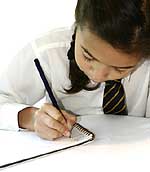| Magazine Home I Links I Contact Us |
|
Home |
Characteristics of Dyslexia
Reading and learning are the two things that determine the success of a child during his school career. First he learns to read. Then he reads to learn. Reading is therefore of paramount importance in the educational process. Unfortunately poor reading skills, and therefore poor learning skills, have become a reality for an alarming number of children. The Institute for Global Education and Service Learning states that 40 percent of American children have difficulty reading or learning to read, and as many as three-quarters of students who are poor readers in third grade will remain poor readers in high school. The word "dyslexia" is often used to refer to the child who has an average or above average IQ and is reading 1 1/2 grades or more below grade level, and whose reading problem is accompanied by the signs below:
No two people with dyslexia are alike. Some may have many symptoms while others may only have a few. Most have strengths that can disguise the dyslexia or call attention away from it. For example, very intelligent children with dyslexia often use their background experiences and listening skills to understand written text without reading it adequately. At some point these concepts and skills become so difficult that coping skills break down and the student begins to fail. This usually happens around third or fourth grade when children start to read textbooks independently to learn. Some students make it to high school or college before becoming overwhelmed with reading difficulties. Many suffer problems of low self-esteem due to the disability. Symptoms can range from very mild to profound. Keep in mind these characteristics are detrimental only after they are no longer age-appropriate. For example, many kindergarten children have problems with directionality, and handwriting is usually difficult for a four-year-old. |
| Home A B C D E F G H I J K L M N O P Q R S T U V W X Y Z |